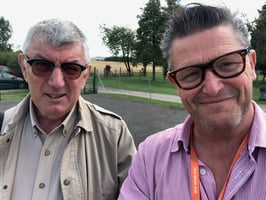I had an email from professional punter Alan Potts, he had a memory of this week's Star Sports...
Professional Punter Alan Potts' Timely Computer Coup!

It's great to find out that people read your blogs, especially people who are betting legends. I had an email from one such person. Alan Potts ( picture above with me ) one of the UK's best known professional punters and an innovator of the art of relieving bookmakers of their money. I have had the pleasure of interviewing Alan on a couple of occasions for Star Sports' #BettingPeople series. If you aren't familiar with Alan, they can be found here. Alan Potts 'Masterclass' and Alan Potts #BettingPeople.
Alan's email was regarding his early, very early, attempt at using a computer to come up with ratings to batter the bookmakers with. I thought that it was a wonderful story so thought that I'd share it, after asking Alan's permission of course. Before I share the story, Alan's email was prompted by a written interview I did with Racing Post Naps winner 2024 Lawrence Taylor which can be found HERE
Anyway, I thought that this was a great tale, so here it is.
Afternoon Simon,
Glad to hear you're recovering OK - I can't remember if I've told you this tale before, apologies if so, but it seemed relevant after reading the piece from Lawrence Taylor.
I reckon I can lay claim to having produced the first ever computerised speed figures for horse racing in the UK, as my program was written in 1967!
I was a computer operator working for IBM at a site in the City. As part of our training for bigger things in our later career, we were required to write a program which could deal with any topic of our choice - the objective was to see if we could handle the technical side of it and produce results. I chose to do something with race times and it was inevitably crude and very basic, as coding software in those days involved using machine language and punched cards.
I opted to deal only with 2yo races over 5F and 6F in order to make the workload manageable. I ended up with two programs - the first took the basic data that I'd put onto punched cards and added to the master file, stored on a tape. I made no distinction between 5F at Epson and 5F at Pontefract, but I did have crude allowances for different going, such as deducting 2 secs from the time if the ground was good to soft and for the distance by which the placed horses had been beaten. I spent many
hours sat at the punch card machine, transcribing the details from the results page of the Sporting Life that summer.
The second program would issue prompts to the typewriter console from which we ran the computer. First it asked distance of race, then how many runners - if I said 8 runners, the program would then loop round 8 times asking for their names. Then it would scan the master tape for the stored data linked to those 8 horses, produce an average time for each runner to cover the distance and then print that off, fastest first, with a prediction of the distances, based on 5L per second. Actually quite sophisticated for 1967 when most companies used their computers for payroll and invoicing and not much else, but of course useless as a means of finding winners, given the flaws in the process.
Then at the end of September 1967, a group of us had planned an afternoon out at Ascot on the Friday of what was then a three day
meeting, with the QE2 on the Saturday. When one of the group noticed a 6F 2yo race in the Thursday evening paper, he persuaded the others to get me to use my program to find the winner. My protests that it wasn't really reliable were dismissed, so I sat down and entered the names of the runners and about half an hour later (computers were very slow in 1967), the printout showed that a horse called Mountain Call was going to win by 6L. Even I was slightly impressed by that, as 6L provided a margin of error to cover up the defects in my program.
He duly won the last race at Ascot on that Friday at 11/2, by 2 1/2L, which led to a number of drunks running the computers on the night shift that Friday! I never used the program again as by the time the 1968 flat season started, I'd been let go by IBM. I never did tell my friends that one reason my program had produced such a confident prediction, was because I had never entered any data for Irish races, so it had no information about the times run by the favourite, trained by V O'Brien and ridden by L Piggott.
Ignorance is bliss!
Alan
.png?width=200&height=200&name=Add%20a%20heading%20(38).png)


